
In the sky, the contest for the fastest bird depends on whether you’re measuring level flight or speed while diving after prey.
Just as the cheetah is known to be the fastest on land amongst the world’s fastest animals, so the birds have their king in the sky.
See the list of the world’s fastest birds ranked from top.
1. Peregrine Falcon
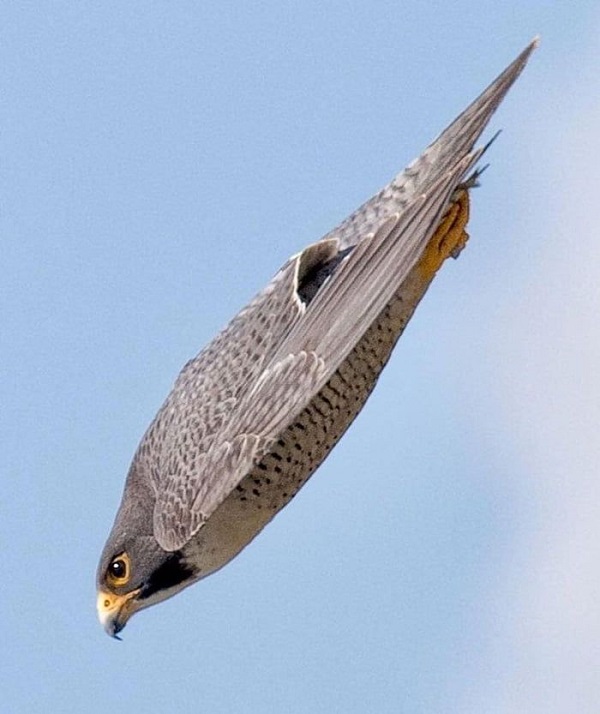
When in level flight, the powerful peregrine falcon zooms at not-too-shabby speeds averaging 25 to 34 mph (40-55 km/h). But when this bird goes after prey, it shows its spectacular abilities.
The peregrine falcon is considered the fastest bird, reaching speeds of up to 240 mph (386 km/h) during its dives, while the white-throated needletail is the fastest in level flight, reaching speeds of up to 169 km/h.
Peregrine falcons are one of the most common birds of prey and are found on all continents except Antarctica. They have been trained for hunting for centuries.
2. Golden Eagle
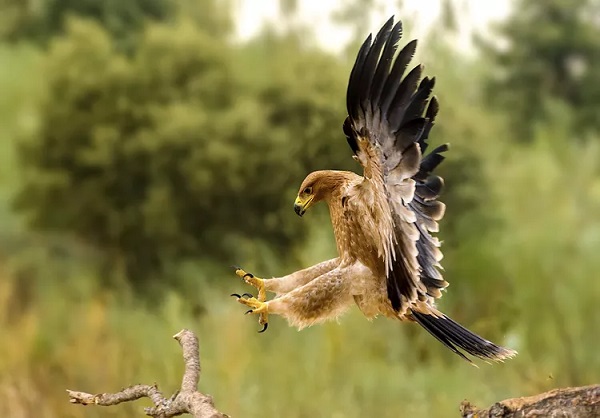
The golden eagle is a powerful brown bird with trademark golden feathers on its head and neck. When preying on rabbits, ground squirrels, and prairie dogs, the golden eagle dives to speeds of 150 to 200 mph.3 Golden eagles use their massive talons to snatch their prey and have even been known to take down deer and livestock. Once feared and hunted by ranchers, they are now protected by law.
These large birds usually spend time alone or in pairs. They like open or partially open country, particularly near mountains, cliffs, and hills. They’re mostly found in the western U.S., rarely in the east.
3. White-throated Needletail

While the peregrine falcon and golden eagle show remarkable speed when diving after prey, other birds are much faster in level flight. Although not scientifically proven, the white-throated needletail is believed by many researchers to be the fastest bird flying in a straight line. Formerly known as the spine-tailed swift, the cigar-shaped bird with the striking white throat can reportedly reach speeds up to 105 mph (169 km/h).
These birds feed in mid-air, catching insects in their beaks. They seek out thermal currents, often on the edges of bushfires or storm fronts, and have special membranes that cover and protect their eyes while feeding.
4. Eurasian Hobby

Recognized for their acrobatic skills, Eurasian hobbies are so athletic that they can pass food to each other mid-flight as they are soaring through the skies. These falcons are believed to be able to reach speeds up to 99 mph (159 km/h) when they snatch small birds and dragonflies out of the air. They prefer open woodland, heathland, and farmland, and they can be found in Africa, Asia, and Europe. They’re occasionally seen on ships far out at sea and even in North America as rare strays.
5. Gyrfalcon

The fierce gyrfalcon is the largest falcon in the world. Large and stocky, they usually hunt birds in the open, flying high and swiftly swooping down on their prey from above. They often hunt birds in open country, sometimes flying high and attacking from above. They also chase their prey, following them from behind, quickly and low to the ground. Some estimates suggest that the gyrfalcon (pronounced “JER-falcon”) flies at least 90 mph (145 km/h) in level flight and 150 mph (241 km/h) when stooping.
The female is substantially larger than the male. They breed on the Arctic tundra and often perch on the ground.
6. Magnificent Frigatebird

Magnificent frigatebirds can fly for weeks at a time. They spend most of their lives soaring in the clouds, often sleeping mid-flight. They rarely flap their wings, but when they do, the wingbeats are slow and deep.
These sea birds catch their prey from the surface of the water or the air. They do not dive. Sometimes they bother other birds, irritating them so much that they cough up whatever fish they’ve eaten, and the magnificent frigatebird swipes it, says NPR. Magnificent frigatebirds do all this at remarkable speeds, reaching an estimated 95 mph (153 km/h) during flight. Males have a distinctive red pouch below their beaks, which they inflate during breeding.
7. Spur-winged Goose
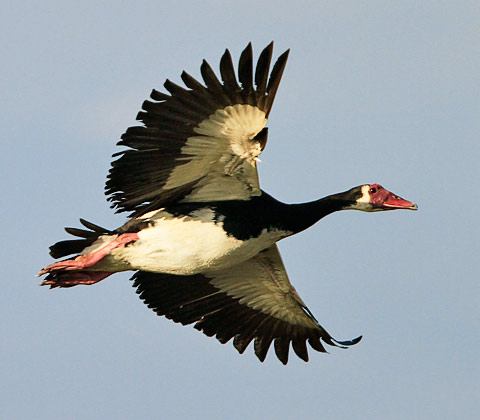
This long-necked, mainly black waterfowl has a white face and large white wing patches. It’s Africa’s largest waterfowl and the largest goose in the world, but when it hits the skies, it soars. The spur-winged goose is estimated to hit speeds as fast as 88 mph (142 km/h).
It mostly forages in wetlands and grasslands for plants. Sometimes, it ingests toxic blister beetles and absorbs the poison (cantharidin), making its flesh toxic for humans to eat.6 It is still threatened by hunting, though, when farmers shoot because of the threat the goose poses to crops.
8. Red-breasted Merganser
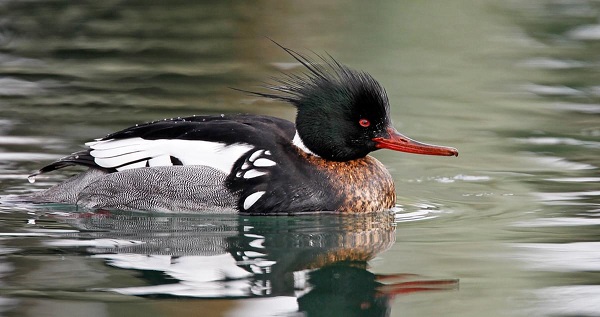
This diving duck has a distinctive head of spiky feathers. These quick ducks have been known to fly as fast as 81 mph (130 km/h), but they need help hitting the skies. To get airborne, they must have a running start, reports the Cornell Lab of Ornithology.7 Their legs are situated near their rear, making it harder for them to walk, but their anatomy helps when diving.
9. Grey-headed Albatross
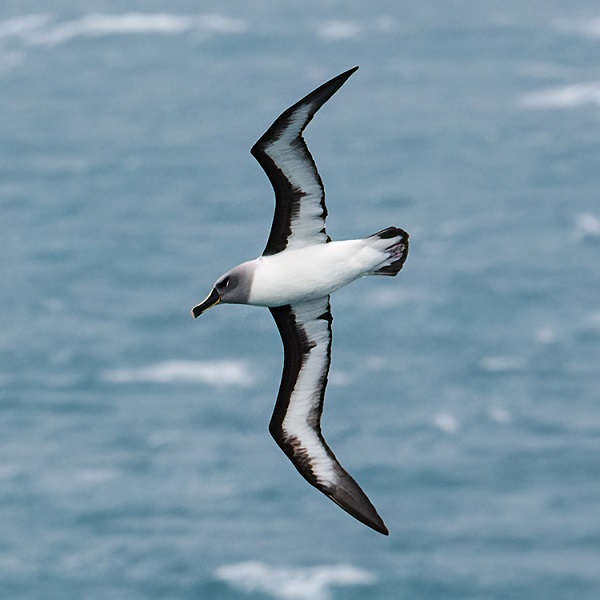
According to French and British researchers working in the sub-Antarctic recorded a grey-headed albatross can fly an average 78.9 mph (127 km/h) during a foraging trip. In their report, published in the journal The Auk, they said the albatross sustained that speed for nearly nine hours “with virtually no rest” during an Antarctic storm.8 “Despite its high speed and the storminess of the sea, the albatross still managed to successfully locate and capture prey at a rate comparable to that achieved under less extreme conditions,” the researchers wrote.
These birds will travel long distances to feed, taking trips up to 8,000 miles (13,000 kilometers), even during breeding season. They usually pluck food from the ocean’s surface but have been known to dive as deep as 23 feet.
10. Common Swift

Although most of these speeds are based on estimates, scientists were able to accurately clock one fast flier. In 2009, researchers from Lund University in southern Sweden used tracking radar to follow common swifts during spring migration, summer roosting flights, and autumn migration.10 They clocked them flying at 47 mph (75 km/h), with one common swift reaching a top speed of 69.3 mph (111.6 km/h).
When common swifts get together to mate—at what scientists call “screaming parties”—they turbo-boost their speed. “They were generally known for flying very fast during this behavior. However, there were no certain measurements of how fast these flights are,” lead author Per Henningsson of Lund University told the BBC. “It is remarkable that a bird that otherwise appears to be ‘finely tuned’ to perform at a narrow range of flight speeds at the same time can fly more than twice as fast when it needs to.“



